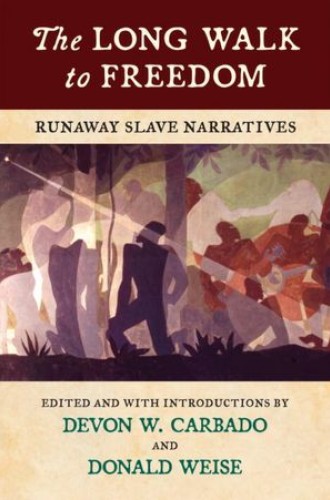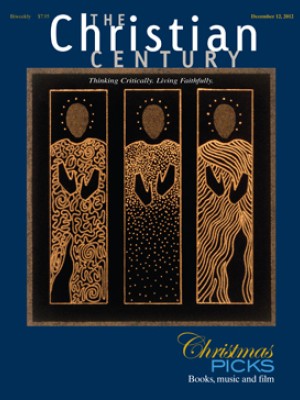The Long Walk to Freedom, edited by Devon W. Carbado and Donald Weise
Why do readers endure the bleak realm of Katniss Everdeen in The Hunger Games? Why do we march through bog and storm with hobbit Frodo Baggins in the Lord of the Rings trilogy? It cannot simply be our love for adventure or our fascination with magical or dystopian lands. We are drawn to the underdog who opposes and overcomes overwhelming forces. We get caught up in the friendships and the love stories of people who maintain families and protect their homes against seemingly insurmountable odds.
Stories we consume by the millions in fiction have a very real counterpart in U.S. history of the 19th century, when African-American writers created literary adventures just as exciting as those crafted by Suzanne Collins and J. R. R. Tolkien. Hundreds of runaway slave narratives detail heart-wrenching dramas of families torn apart and of heroes hiding from hounds or standing up to rapists. They even involve magical escapes during which God answers prayers for liberation. In one case the answer came in the form of a wooden box three feet wide, two feet high and two feet deep. “Get in,” God said, and the slave obeyed.
Read our latest issue or browse back issues.
If you do not believe that these dramas are as moving as The Hunger Games or The Lord of the Rings, take a look at the excerpts of runaway slave narratives brought together by Devon W. Carbado and Donald Weise. If the drama of Frederick Douglass wrestling with his overseer doesn’t get your heart pounding, what will? If you don’t marvel at Henry Brown’s bodily contortions to fit into his wooden box, where he endured more than 20 hours before his “resurrection from the death of slavery,” can anything amaze you? And if you can hold back tears after reading how Bethany Veney stayed up all night with her husband as they tried to concoct a way to avoid his being sold, then you are stronger than me. “We talked late into the night,” she wrote, “and at last, in the silence and dread, worn out with sorrow and fear, my head on his shoulder, we both dropped asleep.” I’m tearing up even as I type her words.
Carbado and Weise present 12 excerpts from various narratives, arranged into four sections. The first section includes episodes in which slaves went “running to be free.” Moses Roper, James Curry and Frederick Douglass bring us to the violence-filled worlds of American slaves. In Roper’s case, for instance, the mistress of the household was so angry that he looked like her husband that she brought a club and knife to the slave cabin, intending to murder him. Roper was six years old. He tried to run away time after time until eventually he was tied to a cotton machine. The torture of his body mirrored the production of the cotton.
Part two carries the emotional stories of slaves who fled for family reasons. Often the final straw was having to endure the sale of their spouses and children. Once separated from their families, many slaves decided to risk death rather than remain in bondage. Bethany Veney fled for freedom shortly after she and her husband “parted forever, in this world.” The third part of the book contains narratives that include religious rationales for liberty. When Nat Turner led the most famous uprising of his generation, he believed that God had told him to do so. More than 40 whites were killed in the rebellion, and afterward terrified whites murdered hundreds of African Americans, many of whom had nothing to do with the uprising.
The final part reveals the creative and death-defying lengths to which some slaves went to achieve their freedom. We enter Henry Brown’s box, travel with him the more than 200 miles from Richmond to Philadelphia and sing Psalm 40 with him as he stands as a free man for the first time; we join Harriet Jacobs in her attic prison, where she fends off the sexual advances of white men and the rage of white women. And we run “a thousand miles” with Ellen and William Craft, who pose, respectively, as a white man and his slave.
For the spiritually inclined, The Long Walk to Freedom has stories of everyday people inspired by God in novel ways. They wondered, as many of us do, what God had made them for and whether God had abandoned them. They looked at the trees and asked, “If the Lord made them free, then why not me.” They prayed from prison cells and from dark forests. And they defended their beliefs against the incredulous and the naysayers. “You may call me superstitious if you like,” explained Isaac Williams, “but I give the facts as they occurred and shall always cling to the belief that it was God himself who spoke to me, and I feel all the happier in doing so.”
Some of the narratives included in the book are accessible for free online in their totality. The University of North Carolina’s digital collection North American Slave Narratives houses more than 300 stories. Visitors can both search the website and browse by subject. Just like The Long Walk to Freedom, the site presents short introductions for each narrative that situate each story and its author in their place. However, on the website the narratives are not edited to highlight their most thrilling aspects. The book accomplishes that nicely.
For too long we have thought of 19th-century American literature simply as novels written by white men and women. Moby-Dick is marvelously bizarre, but after reading these slave narratives, you may find Ishmael’s assertion that “we’re all slaves” to be disingenuous. The Scarlet Letter is powerful, but why should we care more for Hester Prynne than for Harriet Jacobs? If you want to feel the vibe and the pulse of 19th-century America, in its drama, its adventure and its passions, then slave narratives will bring you there.







